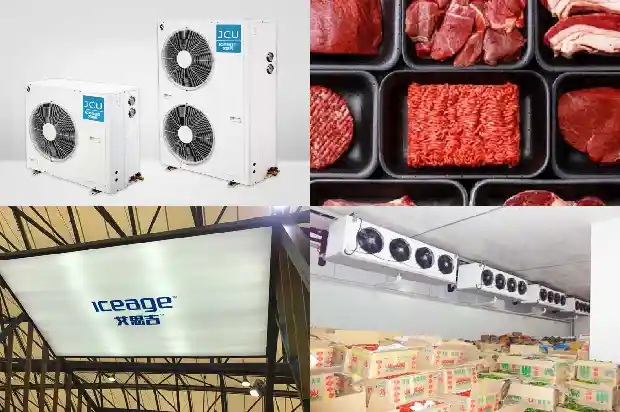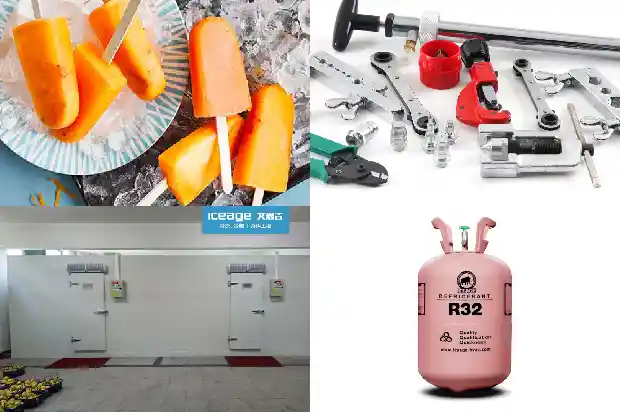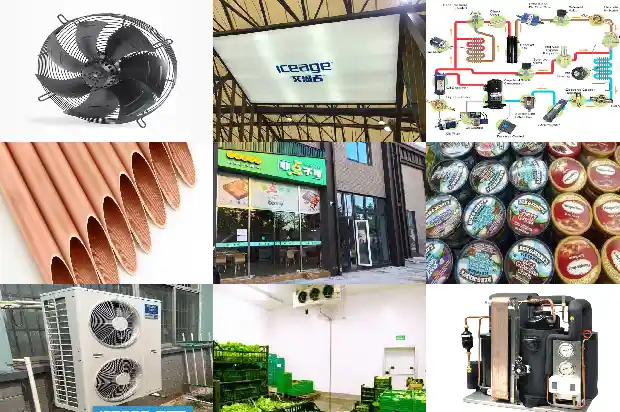Technical Introduction of Process Cooling Water System
2024-09-28
Process cooling water system is an indirect cooling device for key equipment in semiconductor, microelectronics and other industries. It is divided into open system and closed system. This article provides a detailed introduction to the composition, working principle, system characteristics and system mode selection of the process cooling water system.
The application range of process cooling water is very wide, involving all aspects of industrial production. There is a large amount of process cooling water used in places such as semiconductors, microelectronics, industrial refrigerators, steam turbine exhaust condensation in thermal power plants, large central air conditioners, coal chemical plants, petrochemical plants, and natural gas pipeline cooling. In many product or process production environments, clean workshops are required. The temperature and relative humidity in the workshop are required to be maintained within a certain range throughout the year. Some production processes generate a large amount of heat, and process equipment requires low-temperature water cooling. Even in winter, air conditioning cooling is still required. To meet these requirements, a process cooling water system must be constructed. The process cooling water system is divided into two types: open system and closed system.
The application range of process cooling water is very wide, involving all aspects of industrial production. There is a large amount of process cooling water used in places such as semiconductors, microelectronics, industrial refrigerators, steam turbine exhaust condensation in thermal power plants, large central air conditioners, coal chemical plants, petrochemical plants, and natural gas pipeline cooling. In many product or process production environments, clean workshops are required. The temperature and relative humidity in the workshop are required to be maintained within a certain range throughout the year. Some production processes generate a large amount of heat, and process equipment requires low-temperature water cooling. Even in winter, air conditioning cooling is still required. To meet these requirements, a process cooling water system must be constructed. The process cooling water system is divided into two types: open system and closed system.
- Composition and working principle of process cooling water system
The process cooling water system consists of the following parts: chiller, pump, heat exchanger, water tank, filter, and process equipment.
Chiller: Provides a cold source for the cooling water system.
Pump: Pressurizes the water to ensure its circulation in the cooling system.
Heat exchanger: This equipment is used to generate heat exchange between the chilled water system and the cooling water system to transfer the heat generated at the load end of this system to the chilled water system. There are many types of heat exchangers. According to their forms, they can be divided into shell and tube type, plate type, plate fin type, heat pipe type, etc. In comparison, plate heat exchangers have the advantages of small floor area and large heat transfer area. Considering the cost characteristics of the space area of semiconductor factories, equipment with small floor area is preferred to save land area and engineering cost.
Water tank: In an open system, the water tank mainly plays the role of supplementing water sources. In a closed system, an expansion tank needs to be selected for the water tank. The expansion tank has three functions. One is to accommodate and compensate for the expansion and contraction of water in the system. The second is to provide a stable pressure to the closed circulating water system and play a role in stabilizing the system pressure. The third is as an indication of the system makeup water pump. Usually, the expansion tank sends a signal to start or shut down the system makeup water pump.
Filter: Filters out solid particle impurities in the water to purify the water source.
There are two relatively independent systems of chilled water and cooling water in the process cooling water system. The chilled water is provided by the chiller. The chilled water and the cooling water exchange heat to cool the cooling water and thus reduce the temperature of the equipment. Water is pumped from the production equipment through the pump to the heat exchanger. The amount of chilled water is controlled to ensure the water temperature of the process cooling water. After passing through the filter, it is sent to the production line equipment and then back to the pump. Constituting the repeated circulation of process cooling water. The chilled water directly returns to the chiller.
1.
1 Comparison between air-cooled and water-cooled chillers
Air-cooled chillers use air as the cold (hot) medium and are integrated equipment that can be used as both a cold (hot) source. The unit has the advantages of high efficiency, low noise, reasonable structure, simple operation, safe operation, and convenient installation and maintenance.
The air-cooled modular unit eliminates many accessories such as cooling towers, pumps, boilers and corresponding piping systems that are essential for chilled water systems. The system has a simple structure, saves installation space, is convenient for maintenance and management, and saves energy. In addition, the chilled water is not exposed to the air, and the water loss is very small. Therefore, pure water can be used, avoiding the phenomena of condenser scaling and water pipe blockage caused by areas with poor water quality. At the same time, water resources are also saved. Water-cooled chillers rely on water circulation to achieve condensation effect, and then rely on water circulation to take away a certain amount of heat.
Chilled water equipment for process cooling water; usually there are mainly two types: "water-cooled screw unit" and "water-cooled centrifugal unit". The re-cooling of water is carried out through a cooling tower. Therefore, the chilled water must come into contact with the air during the circulation process. Some of the water will continue to be evaporated and lost when passing through the cooling tower. As a result, the content of various minerals and ions in the water is continuously concentrated and increased. In order to maintain the content of various minerals and ions stable at a certain value, a certain amount of cooling water must be added to the system, usually called makeup water, and a certain amount of concentrated water must be discharged to maintain a certain conductivity. Generally, it is called cooling tower sewage discharge.
1.2 Basic composition of chiller
The main components of a chiller are: compressor, evaporator, condenser, and thermal expansion valve.
Compressor: The compressor is the core component of the entire refrigeration system and also the power source for refrigerant compression. Its function is to convert the input electrical energy into mechanical energy and compress the refrigerant.
Evaporator: The evaporator is a heat exchange equipment that absorbs the heat of the cooled medium by the evaporation (actually boiling) of the refrigerant liquid. Its function in the refrigeration system is to absorb heat (or output cooling capacity). In order to ensure that the evaporation process can be carried out stably and continuously, the evaporated gas must be continuously pumped away by the refrigeration compressor to maintain a certain evaporation pressure.
Condenser: In the refrigeration process, the condenser plays the role of outputting thermal energy and condensing the refrigerant. After the high-pressure superheated steam discharged from the refrigeration compressor enters the condenser, it transfers all the heat absorbed during its working process, including the heat absorbed from the evaporator and the refrigeration compressor and in the pipeline, to the surrounding medium (water or air) to take away; the high-pressure superheated refrigerant vapor recondenses into a liquid. (According to different cooling media and cooling methods, condensers can be divided into three categories: water-cooled condensers, air-cooled condensers, and evaporative condensers.)
Thermal expansion valve: The thermal expansion valve is both a flow regulating valve and a throttle valve in refrigeration equipment in the refrigeration system. It is installed between the drying filter and the evaporator in refrigeration equipment. The unit has the advantages of high efficiency, low noise, reasonable structure, simple operation, safe operation, and convenient installation and maintenance.
The air-cooled modular unit eliminates many accessories such as cooling towers, pumps, boilers and corresponding piping systems that are essential for chilled water systems. The system has a simple structure, saves installation space, is convenient for maintenance and management, and saves energy. In addition, the chilled water is not exposed to the air, and the water loss is very small. Therefore, pure water can be used, avoiding the phenomena of condenser scaling and water pipe blockage caused by areas with poor water quality. At the same time, water resources are also saved.
Water-cooled chillers are chilled water equipment that rely on water circulation to achieve condensation effect and then take away a certain amount of heat. Usually there are "water-cooled screw units" and "water-cooled scroll units". The re-cooling of water is carried out through a cooling tower. Therefore, the chilled water must come into contact with the air during the circulation process. Some of the water will continue to be evaporated and lost when passing through the cooling tower. As a result, the content of various minerals and ions in the water is continuously concentrated and increased, eventually leading to scaling. In order to maintain the content of various minerals and ions stable at a certain value, a certain amount of cooling water must be added to the system, usually called makeup water, and a certain amount of concentrated water must be discharged, commonly known as sewage discharge.
1.2 Basic composition of chiller
The main components of a chiller are: compressor, evaporator, condenser, and thermal expansion valve.
Compressor: The compressor is the core component of the entire refrigeration system and also the power source for refrigerant compression. Its function is to convert the input electrical energy into mechanical energy and compress the refrigerant. Evaporator: The evaporator is a heat exchange equipment that absorbs the heat of the cooled medium by the evaporation (actually boiling) of the refrigerant liquid. Its function in the refrigeration system is to absorb heat (or output cooling capacity). In order to ensure that the evaporation process can be carried out stably and continuously, the evaporated gas must be continuously pumped away by the refrigeration compressor to maintain a certain evaporation pressure.
Condenser: In the refrigeration process, the condenser plays the role of outputting thermal energy and condensing the refrigerant. After the high-pressure superheated steam discharged from the refrigeration compressor enters the condenser, it transfers all the heat absorbed during its working process, including the heat absorbed from the evaporator and the refrigeration compressor and in the pipeline, to the surrounding medium (water or air) to take away; the high-pressure superheated refrigerant vapor recondenses into a liquid. (According to different cooling media and cooling methods, condensers can be divided into three categories: water-cooled condensers, air-cooled condensers, and evaporative condensers.)
Thermal expansion valve: The thermal expansion valve is both a flow regulating valve and a throttle valve in refrigeration equipment in the refrigeration system. It is installed between the drying filter and the evaporator in refrigeration equipment. Its temperature sensing bulb is wrapped at the outlet of the evaporator. Its main function is to throttle and reduce the pressure of the high-pressure normal-temperature refrigerant liquid when it flows through the thermal expansion valve, and turn it into low-temperature and low-pressure refrigerant wet vapor (mostly liquid and a small part is steam) to enter the evaporator, and vaporize and absorb heat in the evaporator to achieve the purpose of refrigeration and cooling. - Comparison of characteristics of open and closed systems
The cooling water system is divided into open system and closed system. The closed system is mainly composed of pumps, plate heat exchangers, process equipment, pipe networks and pressure stabilizing equipment. The open system is mainly composed of water tanks, pumps, plate heat exchangers, process equipment and pipe networks.
Similarities between open system and closed system: ①Both are indirect heat transfer;
②The process equipment has relatively high requirements for water quality. Therefore, softened water is required for system makeup water (secondary reverse osmosis water from pure water stations can be used as system makeup water without adding additional water treatment devices);
③The system refrigerant is chilled water from the chiller.
Differences between open system and closed system:
①In the open system, the cooling water is in partial contact with the atmosphere at the water tank;
②The open system cannot utilize the back pressure of the system and is not energy-efficient. - Selection of process cooling water system mode
The mode of the process cooling water system is divided into open system and closed system. In the design process, how to choose an open system or a closed system should be selected according to the following situations:
①When the height difference between the highest point of the process equipment and the pump and plate heat exchanger equipment is relatively large (the height difference exceeds 10m), a closed system is recommended. In this way, the residual pressure and static head of the equipment can be fully utilized;
②When the water supply pressure requirement of process equipment is very high but the pressure difference of the equipment is not large, a closed system is recommended. In this way, the residual pressure of the pipe network can be utilized to reduce the pump head and save energy;
③When the plant process equipment is put into production in stages or batches or the equipment is updated and adjusted frequently, considering the system's debuggability, an open system is recommended. This can speed up the system's debugging and operation. At the same time, due to the addition of a water tank in the system, the system's retained water volume increases. When the cold source is interrupted, it has a certain accident buffering capacity.
④From an energy-saving perspective, adopting a closed system can greatly reduce the head of the process cooling water supply circulating pump. On the one hand, it can save initial investment. On the other hand, it can save energy and reduce operating costs.
⑤When the equipment cooling water temperature can be directly cooled by a cooling tower on the hottest day or when the owner requires less investment, an open system can be adopted. When the equipment cooling water inlet temperature cannot be met by an open cooling tower, a closed system is adopted and chilled water is used as the refrigerant. - Suggestions
The process cooling water system is widely used in semiconductor, microelectronics and other industries. In order to achieve good benefits in improving the stability of system engineering, reducing engineering costs and saving energy, it is very important to select an ideal operating mode according to the actual usage situation in the system engineering design process. This article briefly introduces the composition, working principle, system characteristics and system mode selection of the process cooling water system, which is only for the reference of colleagues in plant affairs when designing the process cooling water system.
Related Articles
- Introduction to Inspection and Handling Methods for Refrigerant Leak in Cold Storage
- Introduction to Control Valves in Refrigeration Systems
- Introduction to Basic Types of Cold Storage
- Introduction to Lithium Bromide Absorption Chillers
- Introduction to the Advantages of Dual - temperature Cold Storage
- Introduction to Various Water Tanks in Air - conditioning Systems
- Introduction to the Cleaning Processes and Methods of Heat Exchangers and Cooling Towers
- Introduction to Six Kinds of Two-stage Compression Refrigeration Systems
- Introduction to Key Points of Compressor Grouping in Quick-freezing Cold Storage
- Introduction to the Construction and Features of Cold Storage in Cold Chain Logistics
- All-round Introduction to Condensers and Evaporators!
- Introduction to Vapor Barrier of Cold Storage and Moisture Protection of Equipment
- Introduction to Oil Collector in Refrigeration System
- Introduction to Air-cooled Chiller
- Introduction to Five Classification Functions of Cold Storage Installation for Refrigeration
- Introduction to Precooling Methods for Fruits and Vegetables
- Introduction to the Relationship between Refrigerants and Cold Storage Temperatures
- Introduction to Types of Condensers in Cold Storage
